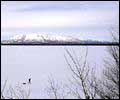



| »Preview »Itinerary »Reports »Maps »Photos »Bios »Iditasport |
||||||

Latest News
Wednesday, March 15, 2000
"I feel super satisfied that I was able to do it and I had the opportunity to do it. And I definitely found my limits. Riding to Nome is as far as I can go, I couldn't go another pedal more...."
[Click for the Latest Dispatch]
The millennium. Is this the year for bigger, farther, higher, better? In Y2k
we get the millennium burger and the millennium latté, everywhere I look
someone or something is telling me to celebrate the year 2000. Well, in
the middle of the frozen 49th state, native villages are preparing for the
"Last Great Race" — Iditarod year 2000. Yes, it's another year for man and
dog to test their skill in the harsh indifferent winter wonderland of
Alaska. Iditarod means "distant place."
 click |
|
When I think of the Iditarod trail, my first thoughts are 65 below zero and wind — the kind of wind that pushes through zippers; zero visibility in blowing snow; and mind-numbing hallucinations. I also see a vast land that is totally indifferent to all humans, let alone a man in a hurry.
Why is Alaska the last frontier? Is it the illusive beauty or supernatural vast expanses? Why, year after year, do athletes from across the lands make pilgrimages to this distant mecca of savage beauty? Alaskans call it Iditarod fever–a test for dog's best friend–The Last Great Race.
| "The road to Nome reads like a bad dream, working to stay on a pace with Iditarod dog mushers, riding over mass quantities of dog s*!t...." |
Well, hold the phone. After two of three human-powered sufferfests, we're on to the big kahuna.
From McGrath we begin the battle to cross the interior of Alaska. Mushers say "this is where man breaks from normal life." As if out here is normal, the wind blows so cold over the next 800 miles you can "piss and lean on it" as they say in the north. For a group of veteran Extreme racers, McGrath is the end of one race and the beginning of another. The continuation of something bigger — millennium bigger, the race to Nome is as big as it gets. Many have tried, 10 have made it, human powered.
The race to Nome is huge, the cash purse small, the fear of failure enormous.
So why do this?
Human-powered to Nome is the crown jewel of wilderness adventure. The road to Nome reads like a bad dream, working to stay on a pace with Iditarod dog mushers, riding over mass quantities of dog s*!t. Pedaling down the brutally cold Yukon River, crossing a splitting, heaving sea ice on Norton Sound and wind, wind and more wind.
Stay tuned for upcoming reports along the Iditarod trail. Take a cyberactive glimpse into the mental maze of two maniacs—striving to be as tough as dogs.
— Pat Norwil, MountainZone.com Correspondent
